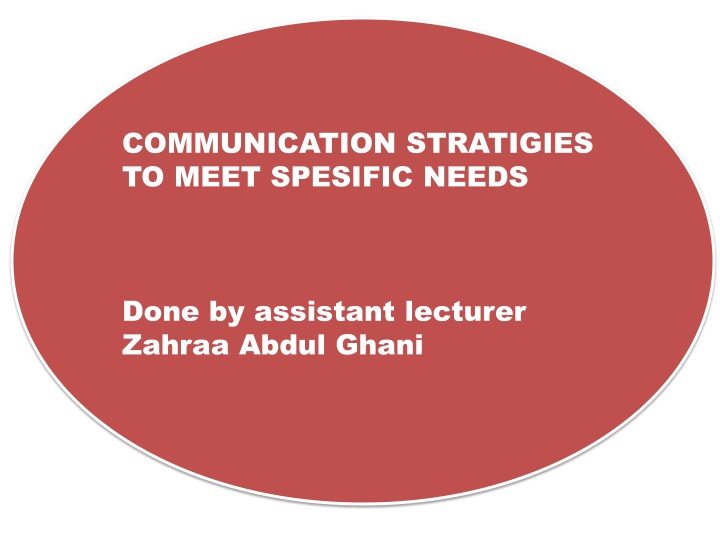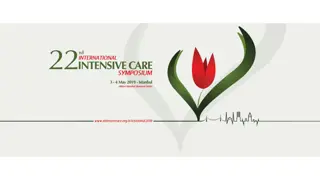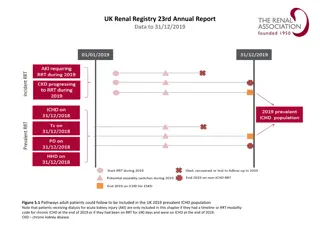
Effective Communication Strategies for Specific Needs
Learn about specialized communication strategies for various situations such as dealing with older adults, individuals with disabilities, and patients from diverse cultural backgrounds. Explore tips for overcoming communication barriers and enhancing patient counseling services.
Download Presentation

Please find below an Image/Link to download the presentation.
The content on the website is provided AS IS for your information and personal use only. It may not be sold, licensed, or shared on other websites without obtaining consent from the author. If you encounter any issues during the download, it is possible that the publisher has removed the file from their server.
You are allowed to download the files provided on this website for personal or commercial use, subject to the condition that they are used lawfully. All files are the property of their respective owners.
The content on the website is provided AS IS for your information and personal use only. It may not be sold, licensed, or shared on other websites without obtaining consent from the author.
E N D
Presentation Transcript
COMMUNICATION STRATIGIES TO MEET SPESIFIC NEEDS Done by assistant lecturer Zahraa Abdul Ghani
COMMUNICATION STRATIGIES TO MEET SPESIFIC NEEDS Overview Some situations require special and unique strategies to ensure effective communication. There are different skills needed to deal with older adults; persons with hearing, sight, or literacy deficiencies; patients with disabilities; terminally ill patients; patients with AIDS; patients with mental health problems; patients from different cultural backgrounds and persons taking care of patients (caregivers).
-Older Adults The number of elderly in our society is increasing, and the elderly consume an amount of prescription and nonprescription medications compared with other age groups. As a group, two out of three elderly people take at least one medication daily. Thus, this growing segment of the population is in need of our patient counseling services. Unfortunately, the aging process sometimes affects certain elements of the communication process in some older adults. Although some elderly patients may appear to be weak, they may not be forgetful or hearing impaired. However, we make certain assumptions based on our perceptions of the elderly as a group of patients. The key is to assess how they are responding to our educational efforts. We should watch for nonverbal signs . Asking open-ended questions can also provide feedback about the patient s ability to communicate.
These potential communication problems are 1-LEARNING In certain individuals, the aging process affects the learning process, but not the ability to learn. Some older adults learn at a slower rate than younger persons . They have the ability to learn, but they process information at a different rate. Thus, the rate of speech and the amount of information presented at one time must meet the individual s ability to comprehend the material. In addition, short term memory, recall, and attention span may be diminished in some elderly patients. The ability to process new solutions to problems might also be slower. Thus, attempts to change behaviors should be: 1-Structured gradually and should build on past experiences. 2-A good style with some older adults is to set short-term goals, and long-term goals in stages. 3- And break down learning tasks into smaller components. 4-Another important step is to encourage feedback from patients as to whether they received your intended message by tactfully asking them to repeat instructions and other information and by watching their nonverbal responses.
2-Value and perceptual differences Potential communication barriers between you and older patients may be attributable to the generation gap. Some older adults may perceive things differently from those in different age groups since people typically adhere to values learned and accepted in their younger years. Thus, some older adults may have different beliefs and perceptions about health care in general and about drugs and pharmacists specifically. Some behaviors, such as hoarding and sharing medication, may seem inappropriate to you, but such actions may make sense to someone who grew up in the 1930s. The image of the pharmacist and the pharmacy profession is also important. Older patients may expect a well-dressed, clean- shaven, professional-looking male practitioner to serve them. If you do not meet these expectations, they may be somewhat reluctant to interact with you initially. Their perception of expert may also influence how they interact with you. Some older adults grew up respecting the ability of physicians and pharmacists and
3-Psychosocial factors Several psychosocial factors may influence your relationship with older adults. First, some older adults may be experiencing a significant amount of loss compared with people of other age groups. For example, their friends may be dying at an increased rate, they may have retired from their jobs, or they may have had to slow down or cease certain activities due to the aging process. Thus, their reaction to certain medical situations, such as ignoring your directions or complaining about the price of their medications, may be responses to fear of their diseases, of becoming even less active, or of dying. They may deny the situation or become angry at you or other health care providers. They may also turn to self-diagnosis and self-treatment or to the use of other people s medications.
Communication Impairments:(Possible patients impairments) Vision Hearing Speech VISION Pharmacists and their staffs work with patients with visual impairments in a variety of practice settings. Be prepared to offer alternative forms of patient counseling to deal with these impairments. If you work with elderly patients, you need to realize that the aging process may affect the visual process. Written messages for persons with visual deficiencies should be in large print and on pastel-colored paper rather than on white paper. Because visual acuity is not as sharp, and sensitivity to color is decreased so in some older patients, more light is needed to stimulate the receptors in the eye.
Hearing Three general types of physical hearing impairment (conductive, sensorineural, and central) can occur singly or in combination with one another. Conductive hearing impairment results when something blocks the conduction of sound into the ear s sensory nerve centers. Sensorineural impairment occurs when the problem is situated in the sensory center of the inner ear. Central hearing impairment occurs when the nerve centers within the brain are affected. A hearing aid is helpful for people with conductive hearing problems, less effective for those with sensorineural impairment, and ineffective for those with central loss. Hearing deficiencies can also be caused by a variety of factors, including birth defects, injuries, and chronic exposure to loud noises.
Aging may also affect the hearing process. Auditory loss in various degrees of severity is seen in more than 50% of all older adults. The hearing loss associated with the aging process is called (presbycusis). Unfortunately, this condition may lead individuals to withdraw socially and psychologically or, in extreme cases, may lead othersto label them as senile or forgetful.
Type hearing impairment in older adults May be describe as being able to hear what others are saying, but not being able to understand what is being said. They can hear words, but they cannot put them together clearly. Other types of hearing loss seen in some older adults are related to diminished response to high-frequency sounds. In some older adults, sensitivity to sound is decreased, and the volume must be increased to stimulate the receptors. Many individuals with hearing deficiencies, rely on speech reading (watching the lips, facial expressions, and gestures) to enhance their communication ability. Speech-reading is more than just lip-reading. It involves receiving visual signals from facial expressions, body postures, and gestures as well as lip movements. Research has shown that everyone develops some speech-reading skill and that the hearing-impaired typically develop that skill much further.
To improve communication with hearing-impaired patients : 1-For speech-reading to be most effective you should position patients directly in front of you . 2- Try to position yourself about 3 to 6 feet away. 3- Never speak directly into the patient s ear because this may distort the message. 4-Wait until the patient can see you before speaking 5-Position yourself on the side of the patient s strongest ear; if necessary, touch the patient on the arm. 6-If your message does not appear to be getting through, you should repeating the same statement and use shorter, simpler sentences.
7-Using a lower tone of voice may help some older adults because in some elderly patients response to high-frequency sounds is usually diminished before the response to lower-frequency sounds 8-It is also important to slow your rate of speech somewhat so that the person can differentiate the words. 9- Remember not to shout when speaking, since shouting may upset some people. 10-Finally, be aware of environmental barriers, such as loud background noises or dimly lit counseling areas, which make communication difficult for the hearing impaired.
Speech In pharmacy practice, you may need to interact with people who have some type of speech impairment. Speech deficiencies can be caused by a variety of factors, such as birth defects, injuries, or illnesses. A common speech deficiency is dysarthria, or interference with normal control of the speech mechanism. Diseases such as Parkinson s disease, multiple sclerosis, as well as strokes and accidents, can cause dysarthria. In dysarthria, speech may be slurred or otherwise difficult to understand because of lack of ability to produce speech sounds correctly, maintain good breath control, or coordinate the movements of the lips, tongue, palate, and larynx. Many of these patients can be helped by certain medications or by therapy from a trained speech pathologist.
Another common speech problem results from the removal of the larynx secondary to throat cancer or other conditions. Such individuals can usually learn to speak again either by learning esophageal speech or by using an electronic device. However, you must be sensitive to these patients, since they sound different. Many people realize they sound different and that they may make other people feel uncomfortable. Thus, they may shy away from interacting with others. To overcome speech barriers, many patients write notes to their pharmacist or use sign language as a means of communicating. Some pharmacists have responded to this need by providing writing pads for patients and even by learning how to sign along with the patient.
Aphasia A group of patients with related speech difficulties are those who suffer from aphasia after a stroke or another adverse event. Aphasia is a complex problem that may result, to varying degrees, in the reduced ability to understand what others are saying and to express oneself. Some patients may have no speech, whereas others may have only mild difficulties in recalling names or words . Others may have problems putting words in their proper order in a sentence. Speech may be limited to short phrases or single words, or smaller words are left out so that the sentence reads like a telegram. The ability to understand oral directions, to read, to write, and to deal with numbers may also be disturbed.
Their problems are due to lack of comprehension; they are not hard of hearing, takes longer to communicate with them, since they may hear the word but may not immediately remember the meaning of it. Patience is also needed, since you may be tempted to fill in the word or phrase for aphasic patients. It is best to let them try to communicate. If they are unsuccessful after a few attempts, help them by supplying a few words in multiple-choice fashion and let them select the word they desire. Aphasic patients often feel isolated and may withdraw from social interactions. Thus, they should be encouraged to interact with other people.
Some aphasic patients have difficulty reading. The difficulty is not one of visual sharpness but rather of understanding written language. Some have severe dyslexia and cannot read at all; others can read single words with comprehension but cannot read sentences. Patients with dyslexia may not be able to write notes to you. Dyslexia is not a physical disability but rather the inability to remember or form conventional written symbols. The key is to be sensitive to their unique needs. As many disabled individuals would say, don t treat me as a disability, treat me as an individual with a disability; in other words, treat me as an individual first. Using common sense and being sensitive to individual needs would be good practices to follow. Due to some disabilities, you may need to interact with the patient s caregiver rather than the patient.
Wheel chair bound patients When talking with patients in wheelchairs, it is important to realize that you may be talking down to them. Although they may be used to having people hovering over them, it is best to talk on the same eye level . Patients appreciate any efforts to minimize the distance between you and them without causing increased attention to the fact that they are in a wheel chair. You should watch patient nonverbal messages to monitor whether they are comfortable during the communication process. You may need to adjust your location or approach if they appear to be straining to hear or do not seem satisfied with the communication environment.
Learning disabled patients Patients with learning disabilities are especially challenging since you do not want to treat them differently, but at the same time you want to make sure that they can understand the critical information that you provide, including how to take the medicine, proper storage requirements, or what side effects to monitor. 1-You may have to repeat key information or use a variety of analogies to make your point. 2- You should not get upset if the patient does not seem to get the main points. 3- Some pharmacists have developed effective written information that is written at the appropriate level to share with their patients. 4-For many patients, you may also have to work with the patient s caregiver to make sure that information is transmitted correctly and used appropriately. 5-If the patient and caregiver are both present, make sure that you speak to the patient, not just to the caregiver, to get them involved with the situation.
Homebound patients A-The key to communicating with homebound patients is to work with patients caregivers when they visit the pharmacy to verify that information is transmitted correctly and used appropriately. B-Clear, brief written information is essential in these situations. It is critical to review this information with the caregiver to make sure that key points are highlighted and are eventually discussed with the patient. C-Communication over the phone or Internet may also be possible . Many homebound patients can use the Internet and thus you may be able to communicate with them via e-mail.
Terminally ill patients Most individuals, including pharmacists, find it somewhat difficult to interact with terminally ill patients. People typically feel uncomfortable discussing the topic of death and are uncertain about what to say; they do not want to say the wrong thing or upset patients. Yet most terminally ill patients need supportive relationships from family members, friends, and pharmacists. Pharmacists are becoming increasingly important in the care of terminally ill patients owing to the complex nature of cancer therapy and pain management and to their increased involvement on oncology teams in hospitals and other institutions.
More important, pharmacists may be the only health professionals in their community who are readily accessible to patients and families. In addition, more patients are receiving palliative care at home. Palliative care seeks to comfort patients and to keep them pain free . A key component of palliative care is effective communication between the patient, the pharmacist, and other health care providers. Managing these unique needs requires strong communication skills; thus, you should be ready, professionally and emotionally, to interact with these patients. The following communication strategies should be used when working with terminally ill patients.
Most strategies require meeting the patients where they are in relation to their understanding of their condition and their stage of adjustment. For example, a patient may be denying the existence of his illness, or he may be angry or depressed about his situation. You would approach these two situations differently. The key is to ask open-ended questions, such as How are you doing today? or How are things going? to determine patient willingness to discuss the situation with you. You should not assume that patients do not want to talk about it. Even if patients do not respond initially, they at least realize that you are willing to talk and may open up at a later time. Before interacting with terminally ill patients, be aware of your own feelings about death and about interacting with terminally ill patients. Being aware of your feelings will help you assist these patients. You should realize that you can handle some situations
As in any type of patient interaction, the degree of involvement depends on your relationship with the patient. You will be more open with some patients than with others. It is also important to explicitly set limits on what you can do for the patient. Many terminally ill patients realize they make other people feel uncomfortable. Thus, they tend to avoid certain interactions. However, if you can express your uneasiness or your frustration about not knowing how to help them at the same time that you express your concern for them, patients will typically feel more comfort and more willing to express their own feelings. You may also come in contact with family members who will probably havespecial needs themselves communicating with terminally ill patients and their families is extremely important.
Patients with HIV or AIDS Patients with HIV or AIDS have special needs that should be considered. For example, many patients do not have an adequate support system, since relationships with family and friends may be strained because of the social stigma. You may or may not feel comfortable becoming a close member of a patient support network or taking an active role in ensuring that patient needs to provide pharmaceutical care services. The key is to identify what the patient s needs are and what services you can provide or referrals you can make to best meet these needs.
1-You may be asked to be part of the patients support system or called on to refer the patient to an appropriate source of support. 2-You may need to supply additional problem-solving support when others are not providing it. 3-Many patients have trouble dealing with their own identity as the disease progresses. 4-Patients are wrestling with a lot of issues and may need some assistance arranging things out. 5- Patients must also deal with misinformation and inaccurate perceptions about HIV and AIDS. 6-You must determine what your role should be in assisting these patients.
Patients with mental health problems Many pharmacists admit that they have difficulty in communicating with patients with mental health disorders. Once again, open-ended questions are good tools to use to determine the level of patient understanding before you counsel them about their medications. Examples include What has the doctor told you about this medication? or This drug can be used for different things. What has your physician said? Asking open-ended questions also helps you determine patient cognitive functioning. That is, are they able to comprehend what you are saying, and can they articulate their concerns to you? If not, you may have to communicate through a caregiver.
Some pharmacists may also be unwilling to distribute written information to patients receiving psychotropic medications for fear that patients may misinterpret the information. Another related concern is that many psychotropic medications are used for non mental health disorders, such as imipramine for bed-wetting or diazepam for muscle spasms. Thus, the written material may not be relevant to the patient s condition and may only cause alarm. The pharmacist should be aware that the ethical responsibility is to provide patients with accurate information in a way that meets their needs to understand their treatments.
Patients with mental illness may be reluctant to interact with pharmacists fora variety of reasons. 1-First, they may have a poor self-concept and may be insecure about interacting with others. 2-They may also realize that they have a condition that makes other people uncomfortable. Thus, this societal stigma about mental illness makes them avoid social interactions. 3-In some cases, patients may be fearful about dealing with other people, especially health care professionals. Thus, your attempts to communicate may find initial patient resistance.
Patients with low health literacy Low health literacy is a pervasive problem that impedes the ability of many patients to understand information we provide them about their medications. Health literacy is the ability to read, understand and act on healthcare information Persons with limited ability to read and comprehend information are frequently embarrassed and fail to release this fact to health care providers. Due to the strong stigma associated with reading problems, many patients will make excuses or try to conceal that fact that they have trouble reading. Unfortunately, health care providers typically fail to assess patients understanding of written information provided to them. Pharmacists should have their patients repeat back instructions to ensure accurate transmission of information.
Cultural Competence As mentioned earlier, you may be working with patients who are different than yourself. Some of these differences relate to culture and ethnic background. Thus, you must have sensitivity to the cultural differences in your diverse patient environment. a few general guidelines are offered to assist you in developing your cultural competence and enhancing your ability to work with patients from diverse backgrounds. Examine the cultural make-up of your practice catchment area. What are the predominant ethnic groups in the neighborhoods surrounding your practice site What are their overall feelings about the accessibility and quality of health care Their trust level regarding health care in general and medication management specifically Speak with community leaders to assess general community beliefs.
Communication skills in pharmacy practice: Have a defined set of values and principles, and demonstrate behaviors, attitudes, policies, and structures that enable members at the organization to work effectively cross-culturally. Should have the capacity to (1) value variety (2) bearing self- assessment (3) manage the dynamics of difference, (4) acquire cultural knowledge (5) adapt to diversity and the cultural contexts of the communities that the organization serve.
Requirements of Cultural Competence in Organizations It is important to assess your patient s ability to comprehend or speak in the language that you are using. If language appears to be a significant barrier to communication, then you must use one of the strategies is by using a staff member who speaks the patient s primary language or using written material that they can understand. Cultural competence is a developmental process that evolves over an extended period. The key is to be sensitive to the differences in beliefs and behaviors within your diverse patient populations. At the same time, you should not stereotype individuals based on their ethnic background . The best strategy is to ask open-ended questions to determine what exactly patients feel about certain elements within their health care.
Caregivers Several special communication problems arise when pharmacists must interact with patient caregivers rather than with the patients themselves. Caregivers can be people who take care of older adults with chronic conditions, parents who take care of children during acute or chronic illnesses, family members, friends, or hired assistants. In general, the number of these caregivers will probably increase in the future, since there has been an increased effort to shift patient care from hospitals to home care. Dealing with caregivers takes a set of specific points 1- You cannot communicate directly with patients and thus cannot determine whether they received your intended message. 2-It is also difficult to assess patient adherence with medication regimens and to offer support and encouragement to patients regarding their medication treatment.
When dealing with caregivers, certain areas should be addressed. a-Caregivers need to understand the patient s condition and treatment and how to communicate specific instructions to the patient. b-Caregivers must also understand how to monitor patient therapeutic response to a specific medication c-How to monitor for adverse drug events, and how to report any suspicious events. D-They should be instructed about the importance of good nutrition and fluid intake for certain types of patients. E-They must be reminded about the refill status of medications and when their physicians need to be contacted. F- Caregivers should be encouraged to contact you if they have any questions or if the patient has specific question
Written information about the medication is essential, since the message should be delivered to patients. A follow-up phone call to patients may also be necessary to make sure that messages were received and to reinforce key points regarding drug therapy. Many pharmacists use medication reminder systems (i.e., drug calendars, weekly medication containers) to help caregivers keep track of medications. In addition, you should develop a special sensitivity to caregivers and should not merely view them as someone picking up the medication.
caregivers have special needs themselves. They may be under a lot of stress trying to care for the patient at home. They may have careers and other activities. Serious depression has been found in almost one-fourth of the individuals caring for the home-bound elderly. In some situations, the caregivers may be patients themselves with their own medical problems. You should also respond empathetically to caregivers and try to understand some of their personal problems. Caregivers have so much stress in their daily lives that it is difficult for them to express their exact need















